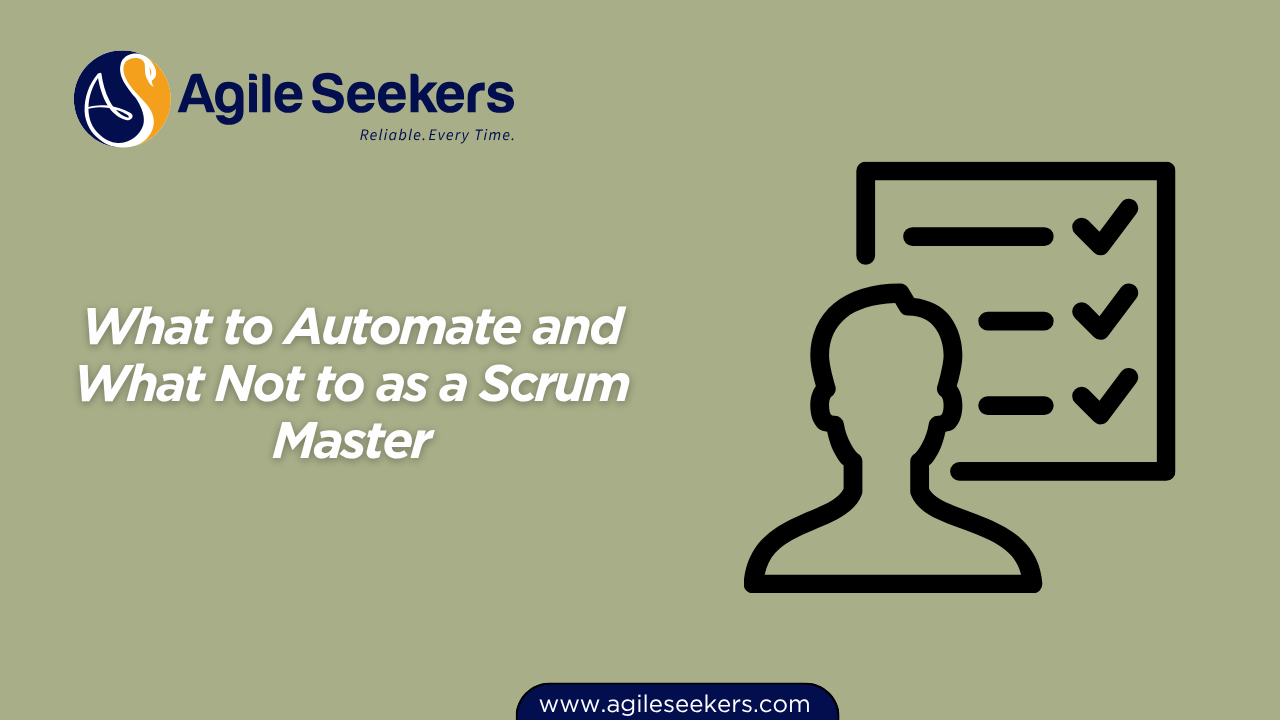What to Automate and What Not to as a Scrum Master

Automation can be a massive enabler for Scrum Masters—but only when applied wisely. If you automate the wrong things, you risk losing visibility, feedback, and even team trust. On the other hand, strategic automation can reduce manual overhead, speed up feedback loops, and help you focus on what really matters: enabling the team.
Let’s break it down. What should you automate as a Scrum Master, and what should you leave human?
✅ What to Automate as a Scrum Master
1. Recurring Status Reports and Dashboards
If you're still manually pulling data for stakeholders, stop. Tools like Jira, Azure DevOps, or ClickUp can auto-generate sprint burn-downs, cumulative flow diagrams, and throughput trends. Set up your dashboards once, then let them run.
Jira Automation Rules can trigger updates or alerts based on conditions like blocked issues or overdue tasks.
2. Workflow Automations in Your Agile Board
You can automate ticket transitions, label assignments, or reviewer notifications. These rules eliminate manual clicks that add up across the sprint.
This is covered in the AI-Driven Sprint Planning for Scrum Masters Certification Training, where you learn how AI helps detect sprint risks early.
3. Meeting Scheduling and Reminders
Use Google Calendar, Slackbots, or MS Teams automations to handle recurring invites and reminders for dailies, reviews, and retros. No more calendar policing.
4. Data Collection for Retros
Use Miro, EasyRetro, or Parabol to send automated feedback surveys post-sprint. You’ll enter retros with themes already highlighted.
5. Team Check-ins and Mood Tracking
Automated Slack or MS Teams nudges like “How are you feeling this sprint?” surface blockers early. These async check-ins reduce meeting fatigue.
❌ What Not to Automate as a Scrum Master
1. Facilitation of Ceremonies
Your presence during standups, retros, and planning isn’t optional. These are human touchpoints that require observation and facilitation. Tools can support—but not replace—you.
2. One-on-One Conversations
These discussions are personal and sensitive. No chatbot can replace a real conversation about burnout, growth, or feedback.
3. Coaching and Conflict Resolution
These require emotional intelligence. Even if analytics show a dip in collaboration, interventions must come from a human. The AI for Scrum Masters Training teaches how to blend analytics with coaching intuition—one complements the other.
4. Sprint Goal Definition
AI can suggest goals based on history, but setting the goal requires team alignment and shared purpose. That can’t be automated.
5. Team Morale and Culture Building
Culture comes from connection, not bots. Recognition and psychological safety are built through genuine interaction, not automated messages.
Questions to Ask Before You Automate
| Question | Why it matters |
|---|---|
| Will this improve team focus or add noise? | Not every automation adds value. Some distract more than help. |
| Am I automating insight or just activity? | Data is only useful if it leads to action. |
| Does this support human decision-making or replace it? | Automation should empower—not override—people. |
| Is the automation visible and transparent to the team? | Silent rules confuse or frustrate if not understood. |
Examples of Smart Automation for Scrum Masters
- Sprint Planning Assistant: AI suggests story slices and highlights scope risks. You still decide, but faster.
- Slack Alerts for Blocked Work: If a ticket stalls for 3+ days, auto-ping the assignee or notify a channel.
- Retro Action Tracking: Automatically follow up on action items from retros. Nudges can be sent a few days before the next sprint.
Don’t Confuse Automation with Delegation
Automation is a tool—not a substitute for ownership. You can automate check-ins, but you must act on them. You can automate insights, but you're responsible for decisions.
Leadership still needs to show up.
How to Get Started
- Map your routines: Spot repetitive tasks.
- Pick one thing to automate: Start small. Try automated sprint reports or backlog grooming nudges.
- Involve the team: Be transparent and get their buy-in.
- Measure and iterate: If it doesn't help, adjust or remove it.
If you want to go deeper into this space, check out the AI for Scrum Masters Training. It helps you use automation to scale your impact without losing your human edge.
And if you’re interested in smarter sprint planning with AI, explore the AI-Driven Sprint Planning for Scrum Masters Certification Training.
Tools to Explore
- Parabol – Async retros and check-ins
- Zapier – Automate workflows between tools
- Tability – Track team OKRs and goals
- Jira Automation – Rule-based workflows
- Geekbot – Async standups and health checks
Final Thought
Scrum Masters don’t need to automate everything. They need to automate intelligently. Let automation handle the routine so you can focus on enabling flow, solving real problems, and being present for your team.
Also read - The Future of Scrum Mastery with Artificial Intelligence
Also see - Building an AI Friendly Culture as a Scrum Master




















